Energy use in buildings contributes to over 40% of the world’s total energy consumption, of which lighting and space cooling make up a significant proportion. Traditional glass windows are the least energy-efficient components in buildings. In the summer, the near-infrared sunlight transmitted through windows produces undesired heating. In turn, the high reflection of mid-infrared limits heats rejection from the building. This “greenhouse effect” aggravates cooling energy consumption.
To counter this problem, researchers at Wuhan University in China have proposed a novel design of hydrogel-glass which consists of a layer of hydrogel and a layer of normal glass that can selectively block heat from the Sun without blocking its light.
The new hydrogel-glass possesses a higher level of visible light transmission, stronger near-infrared light blocking, and higher mid-infrared thermal emittance than traditional glass. Thanks to all these properties, the researchers demonstrate that hydrogel-glass windows can enhance indoor illumination and reduce indoor temperature.

To further demonstrate the potential of the hydrogel-glass for windows in buildings, researchers set the hydrogel-glass on a small house model with a size of 20 cm × 20 cm × 20 cm and measured the illuminance and temperature at different spots. The results showed that the indoor illuminance of the house with hydrogel-glass is slightly higher than that in the house with normal glass on a sunny day.
The enhanced illuminance helps to reduce the electricity consumption from lighting. More importantly, the indoor temperature of the house with the hydrogel-glass is always lower than that of the house with normal glass. The largest temperature reduction reaches 3.5 °C at noon with the highest solar intensity of 58.7 mW/square centimeter.
In tests, the hydrogel-glass achieved a high thermal emittance of 96%, which is higher than that of other transparent radiative cooling windows. The glass exhibited a reflection band at about 9 μm due to the strong refraction, and this led to a low thermal emittance of around 84%.
The average transmittance of the new glass was 92.8%, with a 0.15-mm-thick hydrogel layer. When further increasing the hydrogel thickness to 1.7 and 3.4 mm, it decreased to 92.6% and 92.5%, respectively. The simulations suggest energy savings ranging from 2.37 to 10.45 MJ/square meter per year can be achieved for typical school buildings located in different cities around the world.
With broadband light management covering the visible and thermal infrared regions of the spectrum, hydrogel-glass shows great potential for application in energy-saving windows.
Novel hydrogel-glass design for energy saving in buildings
Source: Tambay News

0 Comments